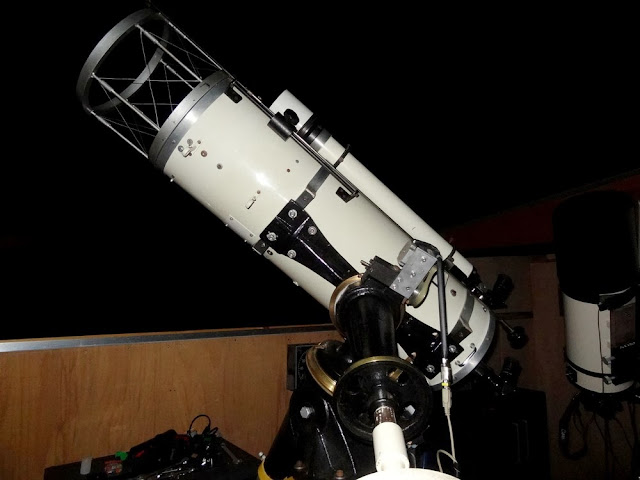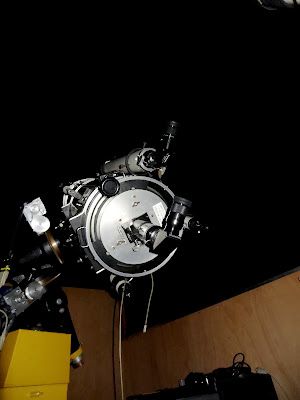*
After a rather long hiatus, with little real work being done on the OTA, the sight of the moon from my bedroom window inspired me to restart work. The sky seems to have been cloudy for months. Some of the new images below have been posed for the camera while I continue work on the OTA. I have removed the various fixing bolts to work on the individual components. The desirability of an ultra-lightweight OTA has been carefully maintained.
The OTA is now taking more permanent shape. A fan cooling port has been cut in the base of the mirror cell 'pot.' A standard 80mm 12V computer fan will sit inside between the cell and the mirror backplate. To give an idea of scale the main spars are 2m or 6'6" long.
The mirror cell backplate has been made from scrap alloy. Actually the base of the secondary cage 'pot.' Not having an 80mm, metal cutting, hole saw, I had to chain drill the large ventilation holes. Then file to a scribed line to smooth things out. This is a very noisy and time consuming business depending on pride in workmanship!
I weighed the alloy disk and it exactly matched a similar circle of 3/4"/18mm multiply, Birch plywood.
The mirror back plate was made a deliberately close, but easy sliding fit in the cell pot. The idea is to make the fan push the air around the mirror blank itself. Not out and around a leaky back plate. Which would rather defeat the exercise of stripping away the thermal boundary layer clinging to the mirror. Any leakage around the mirror back plate would just take air away from the main flow. Possibly leading to a reduced draught and stagnant air hotspots. The tightly fitting backplate will also ensure that the mirror does not shift bodily off-axis with changing telescope orientations.
I cut the aluminium circle roughly to shape with an electric jigsaw. Then allowed the disk to spin it on a central nail in a wooden board, while an angle grinder, with a coarse sanding disk, smoothed the edge to size. Industrial leather gloves and ear defenders were essential. It made quite a pleasant change from listening to the neighbour's endless chainsawing. ;-)
Three galvanised, angle brackets have been fixed to the backplate to retain the mirror laterally. Short lengths of bicycle inner tube have been stretched over the raised legs of these brackets to gently restrain the mirror from flopping forwards at very low altitudes. It is now considered very undesirable to have clips hanging over the front aluminised mirror surface. Causing a massive contribution to overall diffraction. However, the mirror aluminising shows three tab shadows so I am already doomed to have diffraction!
Having the side supporting "rubber bands" near the front surface of the mirror blank will avoid any tendency to become "top heavy." The slight flexibility of the side supports will avoid mirror damage as the OTA is carried in and out of storage in the dark. Though a well shielded outside light may be in my stars.
The original pot lid will be padded with a disk of polystyrene and placed over the mirror cell for safe movement and storage. This will avoid having to reload the main mirror each time I want to observe. Hopefully avoiding the attendant risks to the mirror in carrying it out to the telescope in the dark, over various unseen hurdles, closing doors with elbows, etc.. The mirror will also enjoy an unheated, secure environment prior to every use. While most telescope mirrors must be cooled down from an indoor, centrally heated situation, mine will always be ready to use.
The secondary cage 'pot' now rests on-axis on top of two pieces of aluminium angle. These rails are pop-riveted to the tops of the main spars and have the same semi-matt, silver finish as the main spars.
The previously rather flexible, curved spider vane has been upgraded to a thicker stainless steel rule. The secondary mirror support is now perfectly solid. There proved to be no need to add the intended second curved vane for stiffness.

Obtaining cage rotation is as simple as elongating the single fixing hole into a long slot around the circumference of the pot. However, this assumes the secondary mirror is aligned truly on axis so that it rotates around the optical axis when the whole secondary cage is rotated. Otherwise the collimation will go awry with any secondary cage rotation. I will leave the cage fixed for the moment to judge the desirability of rotation. A simple 150mm x 40mm x 3mm strip of aluminium clamps the secondary cage to the rails without localised pressure or cage distortion.
A view of the mirror cell innards. Three restraining brackets locate the mirror laterally. Coach bolts ensure the collimating screws do not rotate. The 12V computer cooling fan will blow air onto the back of the mirror. The 3-point mirror supports have yet to be fitted.

The art of designing 3-point, mirror support geometry has changed dramatically since I last built a mirror cell! 'Plop' and numerous websites, now specify 0.4 x the mirror Radius. How we ATMs survived, with the gold standard of 0.7R, I have absolutely no idea. 0.4 x 10/2 makes for a tiny 4"/100mm circle. This is not much larger than the 80mm ventilation holes in the backplate and cell.
The mirror cell from the rear/ outside. The three wing nuts are for adjusting primary mirror collimation. They have been deliberately placed on a large circle to ensure fine adjustment. I have used split washers to maintain settings. Though the springs probably provide adequate locking on their own. The coach bolts have doubled springs trapped between the cell and backplate to ensure positive movement for even the smallest adjustments. Any slop in the mirror backplate adjustment can make collimation difficult. e cell and backplate! I just hope they are right!!
The almost completed OTA now weighs 7.3kg = 16lbs without the optics. These will add about an extra 9lbs. Making the final OTA somewhere around 25lbs in total. Which should be manageable.
I plan to split the secondary mirror supporting block to turn it into a clamped see-saw. This will allow two, through, clamping screws to obtain secondary alignment. There being no need to adjust the secondary in all planes. Which merely confuses the issue and makes collimation more difficult. Royce suggested this clever idea on his website.
I still need to address the construction of a shorter and more portable pier for the MkIV Fullerscopes mounting. The original is over 6' high for use with my refractors and is of truly massive weight and proportions. Since the MkIV mounting rests on a heavy steel flange, which itself is welded to the pier pipe, I see no point in cutting the 7" tube any shorter.
So it looks like I'll have to make a temporary pier of plywood and heavy timber once I have the final balance point of the OTA. In theory I could now put the optics in for a trial but will wait until I have a decent support for the mounting. Such a long focus OTA does not really/probably lend itself to a Dobsonian mounting.
My wife has been having gentle fun at my expense with plays on words involving my main telescope building materials:
Pottering about,
Panorama,
Pan-European telescope, built from
Pandora's
pantastic box of parts, ATM
Pandemonium,
Panning the night skies,
Panic observations, maximum planetary
potential.
I think I shall call my new telescope "
Panerphernalia." :-)
Click on any image for an enlargement.
*















































